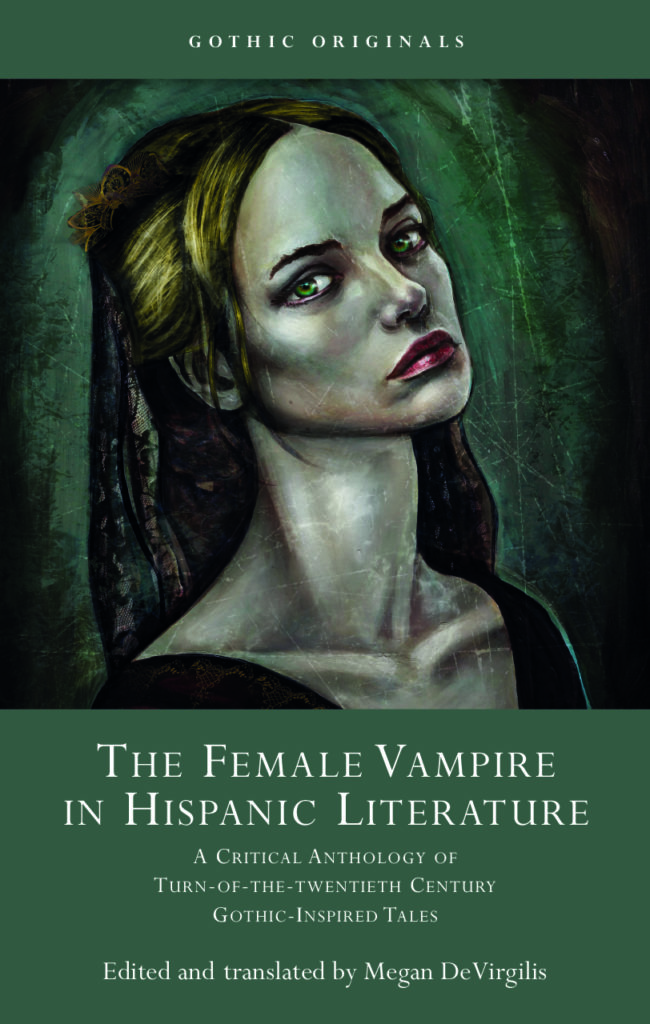
Megan DeVirgilis introduces The Female Vampire in Hispanic Literature: A Critical Anthology of Turn-of-the-Twentieth Century Gothic-Inspired Tales.
My interest in the gothic lies primarily with women as Other; with how female protagonists and women authors create, embody and/or expose ‘monstrosity’. Perhaps this interest in female monstrosity was kindled early on by the fact that my mother, a Cuban political refugee, referred to herself as a ‘legal alien’, leading my young self to quietly believe I was the daughter of an extraterrestrial before I grew to know better. Undoubtedly, enrolling in an undergraduate course on Latin American gothic and fantastic literature prompted my curiosity. The course exposed me to Juana Manuela Gorriti’s short meditations on haunting spaces and places, to the intricate and unexpected inner worlds of Silvina Ocampo’s tormented and tormenting female protagonists, setting me on a path to pursue a doctorate in Spanish with a focus on literature.
I soon became entranced by Emilia Pardo Bazán’s female gothic ethos – an always-lurking patriarchal depravity speckled with bloodsucking metaphors – and Horacio Quiroga’s dark, vampiric depictions of both natural and psychological realms, particularly attuned to love and marriage’s misfortunes. And so, by the end of my second year in graduate school, I had identified the figure of the vampire, so elusive in Spanish and Latin American fiction (or so I thought at the time), as the primary focus of my research. In my dissertation, I devoted a chapter to the female vampire herself, identifying a curious trend of sympathetic and complex vampiric femme fatales that predates similar representations in Anglophone and European literatures by several decades. In my book, I have attempted to stretch both my and her metaphorical wings, giving her the spotlight she deserves.
The Female Vampire in Hispanic Literature is not only the first critical study of the literary female vampire in Spain or Latin America, but also the first to adopt a transatlantic approach to gothic literature in these regions. In addition to identifying the earliest known representations of female vampires, the book also suggests that this trend points to a transatlantic phenomenon that was inspired as much by European Gothic, Romanticism and Decadence as it was by Latin American modernismo, with its penchant for psychology, its underlying sense of despair – even fear – its exploration of the nature and limits of beauty, and its taste for destabilizing literary conventions.
This book also aims to make these tales – three of which have never before been translated into English, and all of which appear here with scholarly annotations and analysis for the first time – accessible to a wider audience. My hope is that undergraduate students, graduate students and scholars are introduced to, or gain a better understanding of, both Hispanic letters and ‘marginalized’ gothics. The tales compiled here offer beautiful, complicated and even nuanced representations of the ‘feminine’, as well as provocative reflections on the challenges of being a woman/object of the male gaze, and of how patriarchal norms can hinder love and happiness for all involved. As four of the five tales are penned by male authors, they also offer insight into how late nineteenth and early twentieth-century societies grappled with rising feminist movements alongside a shifting public/private divide. Indeed, this female vampire trend presents an unexpected response to ‘the woman question’ of the fin de siècle.
This book is both an inquiry into and a celebration of ‘monstrous’ women; that is, of all women, as we continue to carve out spaces for ourselves and each other in a world that wasn’t built for us and that continues to confine us in claustrophobic, even violent spaces and define us based on our physical and emotional capacities as caregivers. It is indebted to my colleagues in Spanish and Latin American Gothic Studies, especially my female crew of collaborators who continue to both inspire and challenge my work. And I hope it inspires other descendants of strange, monstrous, alien women to continue these lines of inquiry.
Megan DeVirgilis, PhD, is Associate Professor of Spanish at Morgan State University in Baltimore, Maryland, US.


